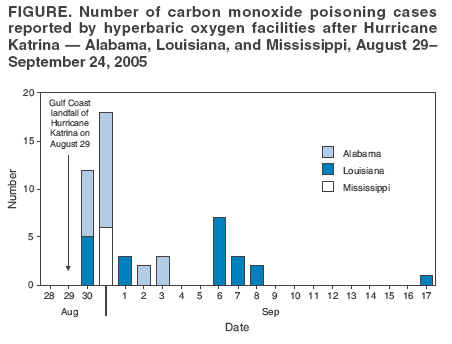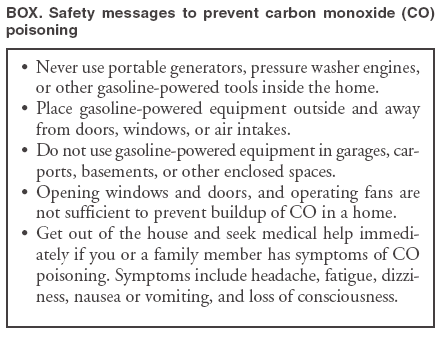 |
|
|
|
|
|
|
| ||||||||||
|
|
|
|
|
|
|
||||
| ||||||||||
|
|
|
|
|
Persons using assistive technology might not be able to fully access information in this file. For assistance, please send e-mail to: mmwrq@cdc.gov. Type 508 Accommodation and the title of the report in the subject line of e-mail. Carbon Monoxide Poisoning After Hurricane Katrina --- Alabama, Louisiana, and Mississippi, August--September 2005On September 30, this report was posted as an MMWR Early Release on the MMWR website (http://www.cdc.gov/mmwr). Hurricane Katrina made landfall on August 29, 2005, on the Gulf Coast of the United States, causing loss of life, widespread property damage, and power outages. After hurricanes, some residents use portable generators and other gasoline-powered appliances for electrical power and cleanup. These devices produce carbon monoxide (CO), and improper use can cause CO poisoning (1,2). During August 29--September 24, a total of 51 cases of CO poisoning were reported by hyperbaric oxygen (HBO2) facilities in Alabama, Louisiana, and Mississippi. This report describes these cases and the rapidly implemented reporting system that identified them. CO poisoning can be prevented by reducing exposure to CO through appropriate placement and ventilation of gasoline-powered engines. Investigations into CO poisonings in Florida after hurricanes in 2004 revealed that approximately 40% of patients had received HBO2 treatment. To monitor cases of CO poisoning from HBO2 facilities in the three affected states, CDC collaborated with the Undersea and Hyperbaric Medicine Society (UHMS) to initiate reporting after Hurricane Katrina. Members of UHMS were asked to report cases, which were compiled and submitted to CDC and shared with each affected state on a daily basis. HBO2 facilities were asked to report information on individual cases and incidents in which multiple persons were poisoned by the same exposure, the date of presentation to the HBO2 facility, state of residence, source of exposure, and the source of HBO2 treatment. Of the 35 HBO2 facilities (Alabama: five, Mississippi: 10, and Louisiana: 20), four (one, two, and one, respectively) reported treating patients. The extent of underreporting of treated patients is unknown. These reports were sent daily to CDC. A case of post-hurricane CO poisoning was defined as one occurring in a patient with a clinical diagnosis of CO poisoning who had resided in a hurricane-affected state (i.e., Alabama, Louisiana, or Mississippi) and whose exposure was reported by an HBO2 facility. Cases of CO poisoning caused by intentional exposures or fire- or smoke-related exposures were excluded. During August 29--September 24, a total of 51 cases of CO poisoning among residents of Alabama, Louisiana, and Mississippi were reported by the HBO2 facilities. These cases included 46 nonfatal CO poisoning cases and five deaths. Among the nonfatal cases, 16 occurred in residents of Louisiana, 24 in residents of Alabama, and six in residents of Mississippi. Among the 46 nonfatal CO poisoning cases, 37 occurred in patients who were treated with HBO2, and nine in patients who received high flow oxygen. None of the patients treated with HBO2 died. All five decedents were Louisiana residents. One exposure incident accounted for four of the deaths and one nonfatal case. Another incident accounted for one death and two nonfatal exposures. Two incidents each involved seven nonfatal cases. A total of 38 (74.5%) of the cases occurred within the first week after the hurricane; the other 13 (25.5%) occurred during September 6--24 (Figure). The source of exposure for all but one of the nonfatal cases was exhaust from a portable generator. One nonfatal case was associated with use of a gasoline-powered pressure washer. The incident in which four deaths and one nonfatal CO poisoning occurred involved use of a generator in a house. The single death with two nonfatal CO poisoning cases involved use of a generator in a garage. The locations of the generators for the other cases were: under a deck (28.6%), near a window (26.2%), in a shed (16.7%), in a garage (11.9%), in a carport (9.5%), and in a basement (7.1%). Since March 15, 2003, CDC and the American Association of Poison Control Centers (AAPCC) have collaborated to facilitate the early detection of chemical exposures of public health importance. Carbon monoxide is one of several exposures monitored. During August 29--September 24, AAPCC reported a total of 58 calls regarding CO exposure: eight in Mississippi, 21 in Alabama, and 29 in Louisiana. No deaths were reported from these exposures. Reported by: NB Hampson, MD, Center for Hyperbaric Medicine, Virginia Mason Medical Center, Seattle, Washington. MW Lai, MD, American Assoc of Poison Control Centers. M McNeil, MD, PhD, P Byers, MD, Mississippi Dept of Health. R Ratard, MD, Louisiana Office of Public Health. M Patel, MD, M Belson, MD, A Stock, PhD, J Ferdinands, PhD, R Funk, DVM, P Meyer, PhD, C Pertowski, MD, National Center for Environmental Health; D Crocker, MD, EIS officer, CDC. Editorial Note:CO poisoning can be difficult to diagnose because the common symptoms are nonspecific (e.g., headache, dizziness, weakness, nausea, vomiting, chest pain, and confusion). Many persons with CO poisoning mistake their symptoms for influenza. CO poisoning can result in loss of consciousness and death. Health-care providers should consider CO poisoning when evaluating patients who have these symptoms, especially after power outages. The reporting system described in this report rapidly identified severe cases of CO poisoning in the wake of Hurricane Katrina and was implemented before Hurricane Rita struck the Texas-Louisiana border on September 24. All nonfatal and fatal CO poisonings in this report were attributed to improper use and ventilation of gasoline-powered equipment and tools. Improper placement of portable generators accounted for 98% of the CO poisonings reported by the HBO2 facilities. The extent of generator use in Alabama, Louisiana, and Mississippi is not known. However, an assessment of generator use in Florida after the 2004 hurricanes indicated that 17.5% of residents used portable generators. Of that group, 5% reported operating the generators indoors (5). The HBO2 facility reports described in this report identified one CO poisoning associated with use of a pressure washer. Pressure washer--associated CO poisonings after a hurricane have not been previously reported but have been documented in certain work settings (6). As the cleanup continues after Hurricane Katrina and Hurricane Rita, monitoring of CO poisoning reports from HBO2 facilities and other sources and education about CO-poisoning prevention will continue in collaboration with state and local health departments and partners. CO poisoning is easily preventable by reducing exposure to CO (Box). CO detectors can alert users when dangerous levels of CO are present. Educating the public on proper placement and operation of portable generators and pressure washers will reduce exposure to CO. In anticipation of CO poisonings after the hurricane, CDC developed CO-poisoning prevention information sheets and collaborated with the New Orleans mayor's office to distribute them. In addition, CDC collaborated with local organizations to work with retailers and rental companies of generators and gasoline-powered tools to alert buyers and renters of the risk for CO poisoning with improper use of this equipment. In Mississippi, community and faith-based organizations distributed educational information about CO in severely affected communities. Additional information about CO poisoning and approaches to prevention is available at http://www.bt.cdc.gov/disasters/carbonmonoxide.asp. The findings in this report are subject to at least four limitations. First, many patients with CO poisoning might not seek medical care. Among those who seek medical care, the diagnosis of CO poisoning might be missed. An estimated 6% of persons with CO poisoning who visit emergency departments are treated with HBO2 (7). HBO2 therapy can benefit patients with a history of obvious CO exposure and moderate-to-severe symptoms of CO toxicity (3,4); however the primary treatment for CO toxicity is the administration of high-flow oxygen by non-rebreather mask, which can be accomplished during the initial patient evaluation and transport (8). Therefore, HBO2 reports also likely underestimate the number of persons with nonfatal CO poisoning. Second, the HBO2 reports likely underestimate the number of fatal CO poisonings because they report only deaths associated with referred cases. Third, because AAPCC members provide consultation to treatment providers and the public, the AAPCC reports do not necessarily represent persons who have CO poisoning diagnosed. Finally, HBO2 and AAPCC reports might report some of the same persons. Because the HBO2 and AAPCC reports did not include personal identifiers, duplicate reports might have occurred. Despite these limitations, reporting from HBO2 facilities and AAPCC members was rapidly coordinated through their respective organizations. These reports provided timely information when data from hospitals, emergency departments, and clinics were not available. Local and state public health infrastructure for disease surveillance and control was disrupted, shifting initial emphasis toward nonstandard mechanisms for disease reporting. HBO2 and AAPCC reports can expedite tracking of CO poisonings when disasters disrupt public health and medical infrastructure. Acknowledgments The findings in this report are based, in part, on contributions by members of the Undersea and Hyperbaric Medical Society, including J Garcia, Springhill Medical Center; C Witz, Terrebone General Medical Center; B Chamberlain, C Wiggins, West Jefferson Medical Center; J Gleaves, MD, Rush Foundation Hospital; and members of the American Association of Poison Control Centers (AAPCC), including AC Bronstein, MD, MP Hughes, MCS, Mississippi Regional PCC; G Smith, Louisiana PCC; JG Fisher III, PharmD, Alabama (Tuscaloosa) PCC; WD King, DrPH, Alabama (Birmingham Regional) PCC; JP Lofgren, MD, Alabama Dept of Public Health. References
Figure  Return to top. Box  Return to top.
Disclaimer All MMWR HTML versions of articles are electronic conversions from ASCII text into HTML. This conversion may have resulted in character translation or format errors in the HTML version. Users should not rely on this HTML document, but are referred to the electronic PDF version and/or the original MMWR paper copy for the official text, figures, and tables. An original paper copy of this issue can be obtained from the Superintendent of Documents, U.S. Government Printing Office (GPO), Washington, DC 20402-9371; telephone: (202) 512-1800. Contact GPO for current prices. **Questions or messages regarding errors in formatting should be addressed to mmwrq@cdc.gov.Date last reviewed: 10/5/2005 |
|||||||||
|